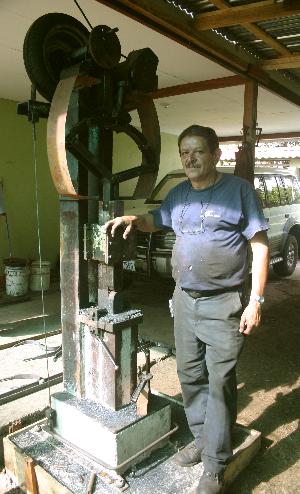|
anvilfire!
Power hammer Page!
Catalog of User Built Hammers |
||
|
CR-JYH Page 1 |
||
 "Yopi" Rodolfo Barvientos Ugalde of Alajuela, Costa Rica with the power hammer he built for Allen Barth.
Yopi was born in 1954 and runs a pump repair shop with all kinds of machine tools.
"Yopi" Rodolfo Barvientos Ugalde of Alajuela, Costa Rica with the power hammer he built for Allen Barth.
Yopi was born in 1954 and runs a pump repair shop with all kinds of machine tools.
In the Aztec religion Yopi is another name for TEZCATLIPOCA, the troublesome creator god. The story Yopi tells is it is a nick name he got as a kid playing at Western Cowboys and being the "Cisco Kid". In his youth he made horseshoes and forged bits from "iredulce" or sweet iron (low carbon steel or wrought iron). He made the rings of stainless steel. To weld small parts he used a conical iron container setting in the forge and piled full of coke. The parts could be held above the hot gases until ready then just clamped together to weld. He said it took about a month to build this machine while doing all the rest of his other shop work. He claims there was never a mechanical hammer in Costa Rica until Josh brought his Fairbanks down and Yopi was the first to build one in Costa Rica. The most useful idea on this hammer is the use of wood for the guide bearings. Many tropical countries have woods in the Rosewood family like the Chiricano (Vantanea barbourii) used on this machine. It is used in Central and South America as a replacement for Lignum vitae in turbine water bearings. | ||
| Allen Barth's Shop is not much different than many part time shops. It is under an open shed roof with a few work benches, anvil and forge. The difference in Costa Rica is that an open air shop is a year round shop. His pride and joy is his Yopi built power hammer. Allen has been blacksmithing about 5 years. | ||
 Mosaic table by Allen with work and DandSI
Mosaic table by Allen with work and DandSI
|
 Detail of dragon candle stick.
Detail of dragon candle stick.
|
|
| When we visited Allen had been using his hammer for several months. As setup it was hard to control but it hit hard and as evidenced from the mounds of scale he was getting good use out of it. However, we were there to demontrate some of Josh's forging tools and techniques and needed more control AND tooling height than the hammer had. So it was tune-up time. | ||

|
 Allen Barth, Yopi Ugalde, Josh Greenwood
Allen Barth, Yopi Ugalde, Josh Greenwood
|
|
|
ABOVE Left adjusting the tire hammer.
Considering that this was the first power hammer Yopi had built based on having only seen one once it ran amazingly well. But a few things were a little out of kilter. There was almost no work space between the dies and the clutch was a little grabby for the speed the hammer was running. So we adjusted the operating stroke to as short as possible and raised the ram as high as possible. Raising the ram required and adjustment with a hacksaw so that the connecting link could be raised full height. |
||

|

|
|
|
After adjusting the hammer Josh made a make shift hand held fullering tool.
He had brought a set of tools but they needed at least 3" tooling height PLUS some hammer stroke.
To use the icanthus leaf fullering tool the hammer needs good control. Here you see the fuller started and run down the leaf. Several grooves were made then widened. The finished leaf was scrolled by hand. |
||

|

|
|
| It is not unusual to need to make some modifications to tune up a Do-It-Yourself or Junk Yard Hammer. Even some of the "kit" or DIY workshop hammers have problems that need fine tuning. The most common problems are incorrect spring tension and at rest die clearance. Some of the workshop built tire hammers are being built with a large tooling space which prevents them from being able to be used with control for plain die drawing and forging. When the die opening is too great the hammer will not work die to die until it is running fast and hitting too hard. | ||

|

|
|
|
|
||